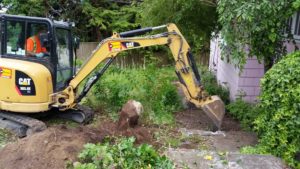
A West Vancouver property inspection post about a search for an underground oil storage tank. Some useful ‘lessons learned’ follow for the buyer who needs to know for certain if there is a buried tank on the property.
This summer I ran into an interesting situation where EKAN Inspection was hired by the buyer as the Owner’s Representative on a demolition project.
The buyer had purchased a property in Altamont with the intention of demolishing the existing house and building a new home. No home inspection was requested by the buyer. The seller issued a disclosure statement stating that there was no buried oil tank and that a clearance certificate from the district would be provided. However in all the paper shuffle at closing, this document was never issued.
I was hired to be the owner’s representative for the demolition. As this was a 80 year old plus house, I called the District of West Vancouver and asked if there was anything registered regarding an underground storage tank at this location. Due to its age, there was a strong possibility that the house was heated with fuel oil. The District directed me to check with the Fire Department, as that was where those records are kept. Unfortunately nothing was on file for the property and this raised a red flag.
I called an underground storage tank (UST) locating service to come out and scan with their metal detector. Next morning Scott, their technician, arrived and we walked the building perimeter clockwise. Nothing conclusive. As there was a concrete patio and walkway around the house, Scott de-tuned the detector to cancel out the false readings from the embedded rebar steel. We also looked at what corner it would be logical to have an oil truck stop to fill-up a tank if there were to be one. On the second pass, walking counterclockwise we hit a hot spot. The reading went off-scale. Further investigation along the foundation perimeter uncovered a copper pipe coming out of the house foundation and goose-necking into the ground.
In BC the seller may be liable for all the removal and cleanup costs. Those can range from under $10k to well over $100k. It all depends if the tank leaked and contaminated the soils and water table.
I informed the agents for the buyers and sellers and was given a free hand to manage the issue. An excavation company was hired with an environmental tech to take soil.
Fortunately the excavation works found no signs of a tank. However there was a steel pipe buried in that suspect location but it was used as a conduit for electrical conductors. The good news was that the tank finding company only charged for the technician’s visit to come and do the scan. There was no charge for the excavation because it turned out to be a ‘false positive’ reading.
The first heating fuel used in the area was coal, then oil, then natural gas. It is possible that this property skipped an era in heating upgrades and went directly from coal to natural gas.
Lessons learned:
- Make sure that all agreed upon documentation is issued at closing. Imagine the disruption to the construction schedule if a tank had been uncovered during the footing excavation stage and then having to deal with ugly delay claims against the sellers.
- Ground penetrating radar is superior technology over a metal detector, for the detection of a buried oil tank. If you want to avoid an excavation to prove that a buried tank exists, consider using radar. It’s a lot less invasive!
2019 Update
For Part 2 of this post, go here.
